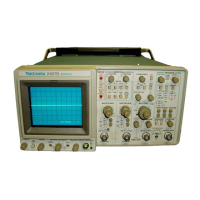Theory of Operation—2465B/2467B Service
Table 3-4
Horizontal Display Selection
Control Level
HSA
H
H
L
L
HSB
H
L
H
L
Selected
Signal
Readout (X)
B Sweep Ramp
A Sweep Ramp
X Input (from CH 1)
Switching between unmagnified (X1) gain and magnified
(X10 gain) is also controlled by signals from the Display
Sequencer. For normal horizontal deflection, the MAG
sig-
nal on pin 14 of U800 is HI, and the gain of the output
amplifier produces normal sweep deflection. Precise X1
deflection gain is set by adjusting X1 Gain pot R860.
When the X10 MAG feature is selected, amplifier gain for
the magnified sweeps is increased by a factor of 10. The
MAG signal from the Display Sequencer goes LO when
magnified sweep is to be displayed. This switches the
amplifier gain and switches analog switch U860C from the
X1 position to the X10 position. Amplifier gain in the
magnified mode is adjusted by adding or subtracting a
small bias current using X10 Gain control R850. Dc offsets
in the amplifier and crt are compensated for, using Horiz
Centering pot R801 to precisely center the display. On the
2465B,
an intensity-dependent position correction signal,
used to hold the horizontal centering stable over a wide
range of varying display intensities, is also added at this
point by the Dynamic Centering circuitry.
Timing and linearity of the sweep is affected by the
amplifier transient response; and Trans Resp pot R802,
connected to pin 2, is adjusted during calibration for
optimum accuracy of the high-speed sweeps.
As with the Vertical Output Amplifier, the Beam Find
feature reduces the dynamic range of the Horizontal Out-
put Amplifier. While the front-panel BEAM FIND button is
pressed in, a HI is placed on U800 pin 15 via pull-up resis-
tor R615, and the horizontal deflection is reduced, moving
horizontally off-screen displays to within the graticule view-
ing area.
Z-Axis Amplifier
Z-Axis Amplifier U950 turns the crt beam off and on at
the desired intensity levels as the oscilloscope goes
through its display sequence. The BRIGHT (brightness)
signal applied to U950 pin 44 from the Display Sequencer
U650 (diagram 5) is amplified to the level required to drive
the crt control grid (via the DC Restorer circuitry) and sets
the crt beam intensity. The BLANK input signal applied to
U950 pin 5, also from the Display Sequencer, blanks the
trace during sweep retrace, chop switching, and readout
blanking by reducing the VZ OUT signal to a blanked level.
Sweep gate z-axis signals ( SGAZ and SGBZ ) from the A
Sweep and B Sweep hybrids (U700 and U900) respec-
tively, (diagram 5) are applied to the Z-Axis Amplifier on
pins 4 and 3. These signals turn the beam current on and
off for the related displays and, when used in conjunction
with the BLANK signal on pin 5, enable the sweeps to be
blanked while still allowing the Readout circuitry to blank
and unblank the crt for the readout displays.
Control signals applied to U950 pin 48, pin 2, and pin 1
( HSA , HSB , and TXY respectively) switch some internal
logic circuitry to enable or disable different input signals for
the various types of displays. Table 3-5 illustrates the
effects of the various input signals on the output signal for
different combinations of HSA , HSB, and TXY.
The Z-Axis hybrid has an internal limiter circuit that
prevents the crt from being damaged during high-intensity,
high-repetition-rate displays. A signal representative of the
intensity setting and the sweep repetition rate is integrated
on C957 and results in a control level at pin 7 of U950
used to limit intensity of the crt beam. Maximum Grid drive
is controlled by R949 on U950 pin 9.
Focus tracking for intensity (VZ OUT) level changes is
provided by the VQ OUT (quadrapole output voltage)
sig-
nal at pin 22 of U950. The VQ OUT signal varies the
focusing voltages (and thus the focusing strength) of two
quadrapole lenses in the crt (diagram 8). The VQ OUT
sig-
nal is related to the VQ OUT level exponentially and pro-
vides the greatest auto-focus control at high intensity lev-
els.
Gain of the VQ OUT signal is set by the High-Drive
Focus adjustment, R1842. On the 2465B, the VQ OUT
signal also drives the Dynamic Centering circuit and holds
the display position stable during wide-range intensity level
changes.
On the 2467B, the transient response of the Z-Axis
Amplifier is adjusted by potentiometer R1834, connected
to U950at pin 13.
Dynamic Centering (2465B only)
The circuit composed of
U3401,
U3402, and associated
components generates compensating signals to offset
positioning effects that occur in the crt when the intensity
is varied over a wide range. The VQ OUT signal from Z-
Axis Amplifier U950 is exponentially proportional to the
display intensity and dynamically controls the intensity-
dependent offsets.
3a-26

